Shark Tagging with South Broward High School
By Dana Tricarico, RJD Intern
Friday October 23, 2015 was officially my second trip as an RJD intern. Needless to say, I was extremely excited to get the day started and to become more familiar with all the jobs on board. It was a beautiful morning for some shark tagging as the team met at the University of Miami’s RSMAS campus to begin the transport of the gear to the dock at Diver’s Paradise. Upon arrival at the dock, we met the group of South Broward High School students, specifically from aspiring marine scientists in the Marine Magnet program, better known as the South Broward “Reef Dogs.” Many of these students were also part of the high school’s Shark Club and/or were RJD citizen science veterans. We also had local volunteers and two science communicators on board as well to help in our efforts and to document the day!
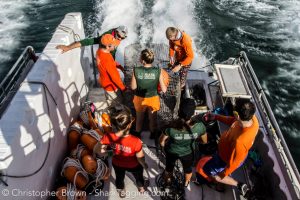
At the start of the day, the team makes the final preparations before the fish traps and drumlins are deployed.
Our trip leader for the day was David Shiffman, who explained to the group the benefits of our gear and how our team deploys it. While David explained this, our team got the gear ready as the boat headed out to our destination. Despite the sunny skies, the wind was strong, so the decision was made to tag in shallower areas within Biscayne Bay. Once all 10 drum lines were placed into the water, Eric Cartaya, captain of our ship, gave a brief history of the area while we waiting for the bait to soak in the water. We learned that the area we chose to tag in that day was right near Soldier Key, the northernmost of the Florida Keys. He also explained that although Key Biscayne is further north, it is not a true key because it is made of sand, and not limestone.
After a full hour passed from the deployment of the first drumline, we began pulling up each of the drumlines with the help of our citizen scientists on board. The first set of 10 drumlines was pulled without any sharks, but we definitely did not lose hope. We continued to place them back in and keep our spirits high with several group shark dances! They must have worked because after we pulled up almost half of the second set up drumlines, we got our first shark- a nurse shark! This was by far the largest nurse shark I had ever seen as it was well over 2 meters. The coloration was extremely interesting because it was so dark.
The South Broward High School students and other volunteers broke into four different teams. Each person within the team had a job which they helped us with once we pulled the shark onto the platform. These jobs routinely include measuring the shark, taking a fin clip and tagging the shark with something we call a “spaghetti tag.” For other species of sharks, we also have the volunteers help us with a stress test by checking the presence of the nictitating membrane on the eye with a squirt of salt water. All of the data collected through these jobs is used in ongoing research projects in the lab, in order to protect these species and to learn more about them. Additionally, volunteers were able to watch RJD intern Laurel Zaima take photos of some of the fins of the shark for morphology information, and were also able to watch intern Jake Jerome take blood from the underside of the tail for his ongoing Master’s research.
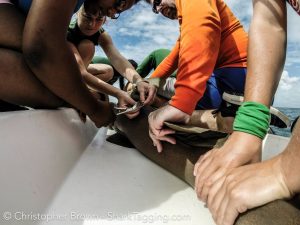
A student takes a finclip, a small cartilage sample that will help reveal long-term toxicology and dietary patterns. Trip leader David Shiffman, and RJD Graduate intern Emily Nelson assists in the process.
The day moved quickly with small rain showers every once in a while to help and cool us off. Later on in the day we were able to tag another large nurse shark with similar coloration to the first we found. David, who has seen a great deal of nurse sharks throughout his research, said that the two nurse sharks we saw were two of the darkest nurse sharks he had ever seen! From my experience, sometimes, people tend to overlook nurse sharks and do not realize how incredible they are. As someone who personally has now had to secure a nurse shark in order to get the necessary data collected, the sheer strength of Nurse Sharks is impressive in itself. I was very lucky to be able to work with both of these sharks, and to do so with a very enthusiastic group of volunteers! Not only that, but I was able to learn from experienced RJD interns who made me increasingly more confident in all the jobs onboard, so I can be even more knowledgeable next time!
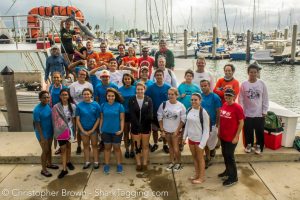
It was a great day for some shark tagging. Thanks to South Broward High School for all of your help!

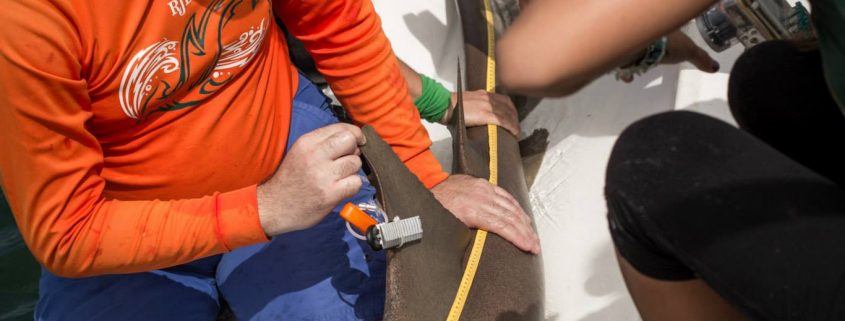
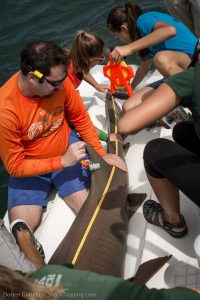


I went on the shark tagging trip on October 23rd. It was a beautiful morning heading out of Biscayne Bay, taking in all the sights and views of the ocean. We deployed thirty five drum lines in all, and got two large nurse sharks in total. Extremely beautiful and interesting creatures to be able to come in such close contact with. I got a lot of refreshers on how to do the enviromentals of the surrounding area where we were catching the Sharks and the jobs that were done on the Sharks to collect the research.
That was a fun trip, it makes me want to be a marine biologist even more.
What an amazing day that was we caught two beautiful nurse sharks both about nine feet in length, it was a rough start with not catching anything but we at least got these two and were able to run our test the team from university of miami lets us do. I learned alot about how they do blood samples and some interesting facts about the program abit more and was an amazing trip to go on again
It was a very educational trip. It shows you what you would have to do if you were to participate or have a career in the field. It was a very great experience although we did only catch two but those two sharks were beautiful so it made up for it. Glorious day expect for the rain but everyone had learned something even if it wasn’t related to the shark trip.
This trip was my first shark trip I’ve ever went on. It was my first time seeing a shark in the wild, so to touch one and to witness such an amazing creature in its natural habitat was amazing. I learned a lot about the process of shark tagging by watching the crew and hands on, reeling in bait and even measuring a nerf shark.